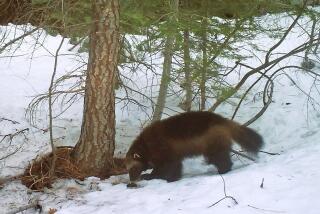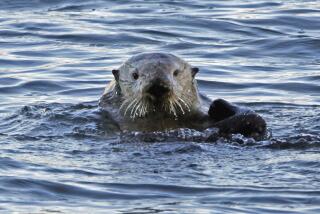5 Species on Rebound Cross Human Paths
- Share via
An alligator in Florida swims through a flood-control canal and ends up in the parking lot of a Miami shopping mall.
A white-tailed deer is captured on a busy street in downtown Washington.
Flocks of Canada geese settle on a Connecticut golf course.
Once-scarce wild turkeys stroll calmly past clogged commuter highways in Virginia.
A foraging black bear wanders into a Pennsylvania back yard.
Not only have the animals survived centuries of hunting and destruction of their habitat, but, surprisingly, along the densely populated East Coast of the United States they are now thriving, thanks to good wildlife-management programs and their own remarkable adaptability.
The pleasure that people may take at the animals’ recovery, however, is being severely tested by the inconvenience and occasional danger they present. For humans and animals, it appears, “normal” life can mean different things.
Decades ago, unrestrained hunting decimated game populations. Laws to control hunting have enabled recovery. A federal excise tax on arms and ammunition has raised more than $2 billion over the past 50 years.
Most of the money has been spent on land acquisition and other programs to aid wildlife development.
Despite all the programs, problems persist in the often-troubled relationship between animals and people, particularly in congested areas like the East Coast.
Bears are a case in point. Powerful and intelligent, they are among the shyest, most retiring of animals. But because their natural predators are few, they do not seem unduly disturbed by human contact.
The danger to people is obvious, but contact is risky for the animals too. Bears accustomed to humans are often shot.
Establishing protected areas such as parks, forests and refuges, and passing laws to regulate hunting have helped the numbers to recover from their low point at the turn of the century. Today an estimated 200,000 black bears range the contiguous 48 states, 40,000 in the East alone.
As bear numbers increase and more people seek recreation in state and national parks and forests, more bears are being killed by cars, and campers are getting an occasional dangerous swat from bears they have fed or teased.
Alligators share bears’ adaptability to humans. Florida condo owners get angry at alligators that menace their pets and children. But the big reptiles have been around for more than 20 million years.
After 200 years of being hunted out of fear or for profit, they were placed on the federal endangered-species list for 10 years, starting in 1967. Today they are considered completely recovered.
As Florida development encroaches on their habitat, some alligators have entered cities and suburbs through flood-control canals and drainages. In 1990, a state commission received nearly 10,000 “nuisance” complaints from frightened citizens.
White-tailed deer, on the other hand, are anything but frightening. But their graceful elegance is belied by a voracious appetite, and they easily get used to humans.
After unrestrained hunting reduced the whitetail population to less than half a million in the late 1800s, deer finally found protection in 20th-Century game laws.
Their comeback has been so successful--as many as 18.5 million whitetails inhabit the United States--that in many areas they are viewed as pests. Their browsing threatens not just commercial crops and timberlands, but suburban and urban trees, flowers and shrubs.
Canada geese bring with them problems similar to those of deer. Migrating flocks pause to feast on crops of grass, corn and wheat. The number of Canada geese in the Atlantic flyway grew from about 180,000 in 1948 to almost a million in 1981.
Although these geese are migratory birds, not all of them migrate. Resident flocks containing hundreds of geese cause significant damage to crops, lawns and coastal parks, where they foul beaches and contaminate suburban ponds.
Another large and sought-after bird, the wild turkey, was nearly eradicated in New England and coastal states south to Maryland in the early 1900s. As many as 10 million turkeys once occupied parts of North America. But by 1900, largely as a result of unrestricted hunting and widespread clear-cutting of forests, that number had been reduced to 30,000. Today wild turkeys can be found in every state except Alaska--with more than 4 million nationwide.
More to Read
Sign up for Essential California
The most important California stories and recommendations in your inbox every morning.
You may occasionally receive promotional content from the Los Angeles Times.













